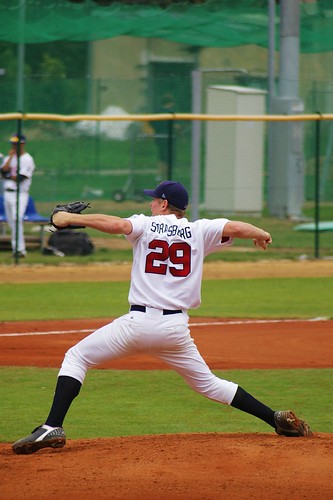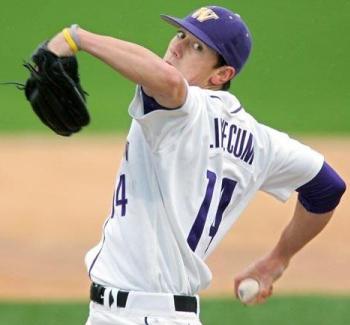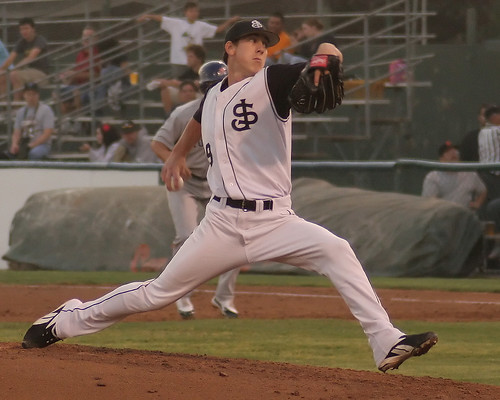Below are a few pictures I've found on the internet of Strasburg at various stages in his delivery. Just by looking at these still shots, it's easy to see that he goes through several awkward stages in his delivery, all aimed at creating a longer path for the ball to travel, which creates higher velocity at release. The short term product is fantastic, but the long term potential for injury from the intense strain applied to the elbow and shoulder could be devastating. I've included several still images of Tim Lincecum's motion to demonstrate the differences in their hip and torso rotation throughout their deliveries.

Notice how Lincecum's hips and torso are slightly closed, while his back foot creates a powerful forward push. The back shoulder looks loose, and the elbow is slightly loaded. In the following still frame, it looks like Strasburg has his hips and shoulders opened up a bit, and his back foot is actually dragging behind him. Whatever forward momentum he has created is now being focused in his shoulder and elbow, which translates into an extreme load for his joints and ligaments to carry over the remainder of his motion.

 Here's another shot showing Lincecum with his hips opened, and his torso following behind them. You can see the torque created just by following the buttons on his jersey from his neck down to his belt buckle, yet his back shoulder still looks loose, and his elbow is only slightly loaded. By comparison, the following picture of Strasburg shows almost a vertical line from his belt buckle up through his shirt buttons. It looks like his hips and shoulders are opening up at the same time, and once again his elbow is the focal point of all of his torque.
Here's another shot showing Lincecum with his hips opened, and his torso following behind them. You can see the torque created just by following the buttons on his jersey from his neck down to his belt buckle, yet his back shoulder still looks loose, and his elbow is only slightly loaded. By comparison, the following picture of Strasburg shows almost a vertical line from his belt buckle up through his shirt buttons. It looks like his hips and shoulders are opening up at the same time, and once again his elbow is the focal point of all of his torque.

Once again, notice how Lincecum's chest stays closed as his hips open, and his back shoulder and elbow remain relatively loose. When you look at the shot of Strasburg below, you can see the front shoulder fly open, transferring the focus of his motion to his back shoulder, which causes his humerus (upper arm bone) to be pulled forward and rotated, torquing his elbow in the process.


Though Lincecum is actually further along in his delivery in the picture above than Strasburg in the picture below (Lincecum's front foot is almost planted and his back foot is rotated, while Strasburg's front foot is still moving forward and his back leg is flexed), Lincecum's front shoulder is more closed than Strasburg's. Once again, the jersey buttons illustrate this point, and while Lincecum's back shoulder is loose enough that he can keep it rotated behind him, Strasburg's back shoulder is already rotating, and his elbow is torquing upwards.

I'm in no way saying that Lincecum will never have a severe arm injury, or that Strasburg is an inferior pitcher. I think they are both very gifted and I hope they both have long, productive careers. However, there are several ways to create extreme velocity and torque while pitching, and the longer you can keep your pitching shoulder and elbow out of the process, the better. And while it may not seem like an important part of the pitching motion, a pitcher's follow through creates a significant amount of strain on the shoulder if not performed properly. Notice how Lincecum's hips continue to rotate forward in the picture below, allowing his shoulder to hang with minimal tension.

Unfortunately, Strasburg's hips stay closed at the end of his delivery, and his shoulder bears the brunt of the strain. Notice how tense his neck muscles are, all of which are connected in some way to his clavicle and shoulder. His pitching arm wraps around him, and the stress in his jersey at his shoulder creates a very striking image when compared to the image of Lincecum above.

Anyways, I'm no expert when it comes to pitcher mechanics and sport kinesthetics, but after reading the Drive Line article, I started thinking about some of the red flags in Strasburg's delivery, and how other pitchers like Lincecum can create very similar results, but reduce their injury risk with subtle changes of body movement. Good luck to both of them, as well as the team that signs Strasburg this summer.




2 comments:
Hey Adam,
Thanks for your thoughts... The comparisons are obvious. And if young pitchers are going to look for a role model, then Lincecum is the winner. His mechanics are customized to provide maximum production without sacrificing his arm. The trunk of a pitcher is crucial. I hope you continue to share this info and help educate our pitchers.
Thanks,
Greg
Thanks for the comment Greg. I'm a big believer in the Lincecum motion, and I think a lot of the old time pitchers that threw complete game after complete game well into their 30's shared a lot of the same core elements with Lincecum's delivery. Young pitchers can definitely learn a lot by watching and emulating Tiny Tim.
Adam G.
Post a Comment